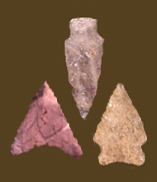
Maryland's PrehistoryArchaeologists studying the history of Maryland’s Indians generally divide the prehistoric era into three periods –Paleoindian, Archaic, and Woodland – although there is some disagreement on the ages of each. The Archaic and Woodland are typically further separated into three sub-periods. The dates of these periods are often given in radiocarbon years before present, but in this essay the dates have been converted to traditional calendar years. Paleoindian (approximately 11000 B.C. – 9500 B.C.) Archaic (approximately 9500 B.C. – 1250 B.C.) The Middle Archaic (7000 B.C. – 3750 B.C.) was marked by rising temperatures and the development of a more seasonally variable climate. Oak-hemlock-hickory forests dominated the landscape, providing extensive mast crops of acorns and nuts, food for humans and game. The embayment of the Susquehanna drainage was underway, and as a result oysters may have been available for harvesting, although widespread use of this resource did not begin until the Late Archaic period. Settlement tended to center around inland swamps, with short-term camps in the upland areas. Group mobility and territory size probably decreased as populations increased. The Middle Archaic is characterized by the appearance of new projectile point types, as well as an increase in tool diversity. Atlatl weights, celts, adzes, grooved axes, and plant-processing tools such as mortars and pestles become more common, suggesting that a wider range of environments and food resources was being exploited. The Late Archaic (3750 B.C. – 1250 B.C.) appears to have been an era of increasing populations and sedentism, which may have led to a diversification of socio-ethnic groups with smaller territories. Settlement was focused on estuaries, freshwater streams, and inland swamps. Exploited estuarine resources included anadromous fish, shellfish, and waterfowl. Deer, small mammals, turkeys, and turtles were all hunted, and nuts and other plant foods were extensively collected. A number of new projectile point types appear, along with new technologies, such as steatite bowls. The Chesapeake Bay and the plant communities that surround it had largely achieved their current states during the Late Archaic. Woodland (approximately 1250 B.C. - A.D. 1600) The trend towards increased sedentism appears to have continued during the Middle Woodland (A.D. 50 – A.D. 950), while long-distance trade seems to have expanded. The pattern of seasonal movement between larger multi-band base camps and smaller, family-sized summer camps continued. A wide range of aquatic and upland environments were exploited for food and other resources. Seed plants such as amaranth and chenopodia were intensively collected, and bone analysis suggests many Indian groups had a carbohydrate-rich diet which was in transition from traditional hunting/foraging to agriculture. New ceramic types, like Watson and Mockely, and new projectile points, such as Selby Bay/Fox Creek and Jack’s Reef, were introduced. During the Late Woodland (A.D. 950 – A.D. 1600) the pattern of increased sedentism and political nucleation continued, although there was still some seasonal movement. Late Woodland sites were typically situated near large streams, often in areas with soil suitable for agriculture. Around 700 years ago, larger villages began to develop, with outlying hamlets and resource procurement sites. Some of these villages consisted of widely dispersed houses, while others were at least partially contained within palisades. The palisades suggest that warfare was common among Late Woodland groups, although they could also have functioned as symbolic enclosures. The villages were moved periodically, probably in response to the depletion of local resources such as firewood and fertile soil. The cultivation of corn, squash, and beans became widespread during this period, although wild game and plants were still extensively exploited. The most important technological innovation of the period was the introduction of the bow and arrow. Bone tools, beads, and clay tobacco pipes are also common on Late Woodland sites. Ceramic vessels were often thinly potted and extensively decorated. The Late Woodland period ends when sustained contact between Indians and non-Indians begins. Additional information can be obtained for these time periods from the following sources: Curry and Kavanagh 1991; Custer 1983, 1989, 1996b; Dent 1995; Gardner 1982; Herbert 1994; Kavanagh 1982; Kavanagh and Ebright 1988; Reeve and Seigel 1994; Steponaitis 1980; Wall 1993b, 2001; Wanser 1982. |
![]()
Search by Shape:
(See Projectile Point Typology) |

|
Thank you for visiting our website. If you have any
questions, comments, Copyright © 2002 by |

|
